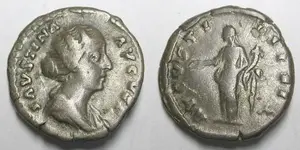HOLA amigos,
Crusader wrote
I call imitations fakes but they are ancient ones & not modern.
You are sure welcome to call them what you will, and perhaps you have it right - but it is equally possible that such "imitations" were not intended to be "fakes" as they were struck for use in circulation by the local authorities of the time. It would then be more correct to refer to them as
"Imitative Issues" rather than "Imitations" which has a more negative implication. Many of the "imitative" coppers as you probably well know, commonly referred to as "Limes" were often made by "barbarians" not as some kind of counterfeits but for local use. If this example is a local imitative issue, it is a very good one IMHO - some look considerably more crude. This example may well be an authentic Roman coin, and we cannot judge it by a few blundered letters for such examples of blundered legends are well known. I don't have my ref books handy or would venture a more specific guess on this coin. I own a Gallic imitative drachm of a Greek coin I wish I could post a photo of for side-by-side comparison of the level of artistic work on the portrait, sometimes these "imitative" issues had quite good engraving work, if often with blundered and - or garbled (or even missing) lettering.
For that matter, many British coins were struck in imitative style of ancient Roman and Greek coins, so would you want to call them "imitations"? It is much the same case - the coins were struck in imitation of the style and design of the foreign coins, not as some kind of counterfeits.
A very COOL coin to find, congrats!

Oroblanco









 ) of what is now known as a Chernyakhovskaya archaeological culture (covered modern Ukraine, Moldova and Romania in the 2nd through 4th centuries AD; commonly called by historians as Goths). As a prototype to this coin there might'd been taken this issue of Antoninus Pius with Pax on the reverse (RIC153):
) of what is now known as a Chernyakhovskaya archaeological culture (covered modern Ukraine, Moldova and Romania in the 2nd through 4th centuries AD; commonly called by historians as Goths). As a prototype to this coin there might'd been taken this issue of Antoninus Pius with Pax on the reverse (RIC153): 








 Volos...
Volos...
